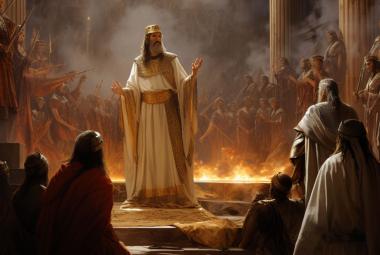John’s Gospel is intense and uniquely rewarding for both the novice and the seasoned Bible student. It is a fruitful place for a beginner, yet it continues to reveal surprises to challenge the most sophisticated and diligent.
Each of the Gospel writers presents a unique perspective, and their selection of events and other aspects supports their respective themes. John’s Gospel unabashedly presents Jesus as the Son of God, and he opens it with the “genealogy” of the Preexistent One.
Summary of Themes
Each of the four Gospels can be summarized by the following themes:
- Matthew presents “the Promised One is here”; see His credentials.
- Mark, “This is how He worked”; see His power.
- Luke, “This is what He was like”; see His nature.
- John, “This is who He really was”; see His Godship.
John, the author of five New Testament books, is the most mystical of Jesus’ disciples. His Gospel is clearly inexhaustible: “It is shallow enough for a child to wade in, yet it’s deep enough for an elephant to bathe in!”
It is a fruitful place for a beginner to start, yet it continues to reveal surprises to challenge the most sophisticated and diligent!
This book includes many distinctive treasures: it explains the enigma of Moses’ brazen serpent in Chapter 3;1 it shreds the heretical “Deutero-Isaiah” theory in Chapter 12;2 it anticipates the Rapture in Chapter 14;3 and, gives us a rare glimpse into the real “Lord’s Prayer” in Chapter 17.
Why Was John’s Gospel Written?
And many other signs truly did Jesus in the presence of His disciples, which are not written in this book: But these are written, that ye might believe that Jesus is the Christ, the Son of God, and that believing you might have life through His name.
The book of John is different than the “Synoptics” as it covers only 21 days of Jesus’ 3 ½ years of ministry. It devotes 10 of 21 chapters to just one week; one-third of the verses (237 of 879 verses) cover a single 24-hour period in Jesus’ ministry.
John depicts Jesus as “more than a man.”4 His Gospel covers the rejection of the “Sent One” and the truth of the new birth.5
Seven Miracles
The Gospel of John is built around seven miracles of Jesus:
- Changing water into wine in Cana (John 2:1–11)
- Healing an official’s son in Capernaum (John 4:46–54)
- Healing an invalid at the Pool of Bethesda (John 5:1–18)
- Feeding the 5,000 near the Sea of Galilee (John 6:5–14)
- Walking on the water of the Sea of Galilee (John 6:16–21)
- Healing a blind man in Jerusalem (John 9:1–7)
- Raising dead Lazarus in Bethany (John 11:1–45)
The key verse of this Gospel is found in the first chapter:
He came unto His own, but His own received Him not, but as many as received Him, to them gave He power to become the sons of God, even to them that believe on His name.
Who did “receive Him”? Peter, Nathaniel, and Philip; Nicodemus in Chapter 3; the woman by the well in Chapter 4; the man born blind in Chapter 9; Mary and Martha at Bethany in Chapter 11; the eleven apostles in Chapters 13 and 14; and Mary Magdalene.
I love the confrontation in the Gospel of John when he speaks of Abraham—“before Abraham was, I AM.”
Jesus is here declaring that He is the voice of the burning bush. Now, anytime that you and I might miss the implication of something, the Pharisees come to our rescue. They took up stones to cast at Him. Why were they so upset? Because they recognized what He was saying.
Seven “I AM” Statements
The Gospel of John is built on His seven “I AM” statements:
- I AM the Bread of Life (John 6:48)
- I AM the light of the world (John 8:12)
- I AM the door (John 10:9)
- I AM the good shepherd (John 10:11)
- I AM the resurrection and the life (John 11:35)
- I AM the way, the truth, and the life (John 14:6)
- I AM the true vine (John 15:1)
Seven Furnishings of the Tabernacle
Jesus also laid claim on each of the seven furnishings of the Tabernacle:
- The Door
- Altar of sacrifice
- Washing (laver)
- Menorah (light of the world)
- Golden altar (prayers)
- The Ark
- The Mercy Seat
All of these declared that Jesus Christ is the fulfillment of what those were foreshadowing. Compare the three statements of John 1:1 and John 1:14:
In the beginning was the Word
And the Word was made flesh
And the Word was with God
And the Word dwelt among us;
And the Word was God;
Full of grace and truth.
John also provides a detailed record of the events in the Upper Room, in Gethsemane, the six trials, the Crucifixion, and the Resurrection. John’s entire Gospel is intense and uniquely rewarding for both the novice and the highly seasoned and diligent.
This classic study has been rerecorded and updated and is now available on DVD.
Notes:
- John 3:14–17.
- John 12:37–41.
- John 14:2,3.
- Isaiah 9:6; Micah 5:2.
- Believers only—Caiaphas’ prophecy; John 11:49–52.






